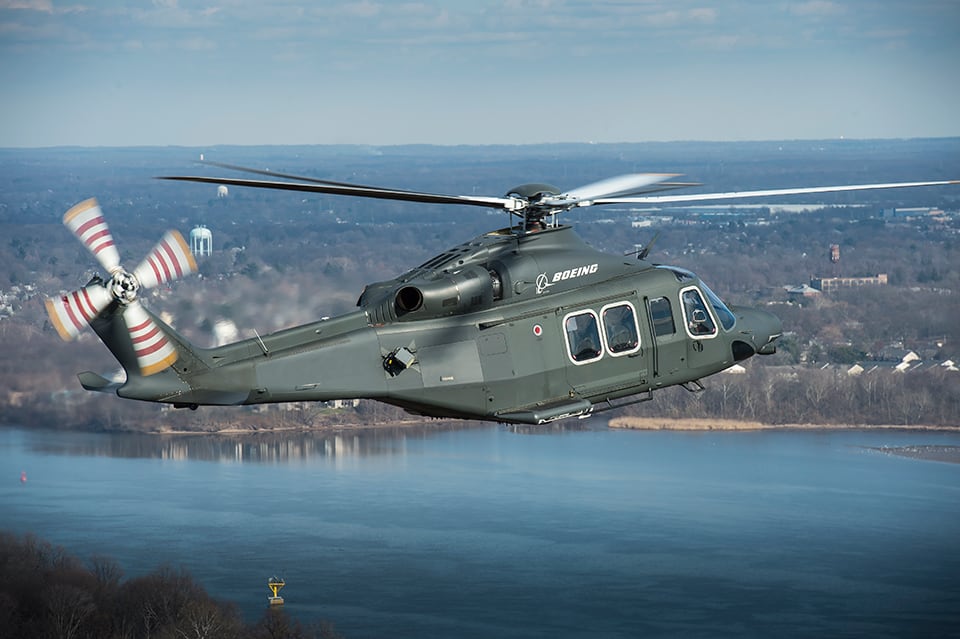WASHINGTON — The U.S. Air Force’s new MH-139 Grey Wolf helicopter, which will replace the UH-1N Huey that guards nuclear missile fields, is at risk for bursting over its weight limit, a congressional watchdog said earlier this month.
The Grey Wolf — built by prime contractor Boeing and based on Italian aerospace firm Leonardo’s AW139 helicopter — appears to be gliding through its development phase, having completed its critical design review five months earlier than predicted in June 2019. However, the Government Accountability Office has voiced concerns that the final weight of the aircraft could be more than expected and lead to some performance drawbacks.
“The helicopter, as it is currently designed, may not be able to meet all performance requirements if the final weight of the aircraft exceeds design parameters,” the GAO said in a June report on major defense acquisition programs. “If an appropriate weight is not achieved, the aircraft may not be able to meet requirements for speed or range. Air Force officials stated that they expect to determine the final weight of the aircraft in December 2019.”
RELATED

In response to questions from Defense News, the Air Force said it knew about the risk of excess weight since it awarded the contract to Boeing in 2018, and it is keeping an eye on the issue.
“The Air Force has been closely monitoring monthly weight reports from Boeing. To date, the aircraft weight is within requirements to meet speed and range key performance parameters,” Air Force spokeswoman Maj. Cara Bousie said.
The MH-139 should be able to hit a 135-knot cruise speed and fly for at least 3 hours — and a minimum distance of 225 nautical miles — without needing to be refueled. Like the UH-1N Huey before it, the Grey Wolf will be able to carry nine fully loaded troops, although the Air Force at one point considered a requirement for its Huey replacement helicopter to carry a larger number.
A weight gain could impact all of those performance characteristics.
The Air Force plans to buy 84 Grey Wolf helicopters over the course of the program. The aircraft will be used for a wide variety of missions, including defending intercontinental ballistic missile fields, search and rescue, and other activities in the national capital region.
The GAO identified one other issue as a possible source for cost and schedule growth: a possible Federal Aviation Administration requirement for additional testing of the engine’s power, which is needed to obtain airworthiness certification.
But “after discussions with the FAA, the Air Force does not anticipate additional testing will be required to demonstrate engine power,” Bousie said.
Boeing spokesman Jerry Drelling said the company continues to work with the FAA on MH-139 certification.
“We are working closely with our customer to execute the current joint flight test program in Florida, which started in December 2019,” he said. “As the Air Force mentioned previously, the test schedule remains on track to support the program milestones.”
The Air Force accepted its first MH-139 in December, one day after the first detachment was formed at Duke Field. The Air Force said at the time that Detachment 7 would eventually relocate to Malmstrom Air Force Base, Montana, and operate a total of four Grey Wolf helicopters in support of test and evaluation activities.
Boeing won a $2.38 billion firm, fixed-price award for the Huey replacement in September 2018, offering a price $1.7 billion less than the program’s initial estimate. Of that sum, so far the company has received an initial $375 million for the first four helicopters and the integration of military-specific items necessary for the AW139 to meet the Air Force’s requirements.
The Air Force is set to make a low-rate initial production decision in September 2021, the GAO said.
Valerie Insinna is Defense News' air warfare reporter. She previously worked the Navy/congressional beats for Defense Daily, which followed almost three years as a staff writer for National Defense Magazine. Prior to that, she worked as an editorial assistant for the Tokyo Shimbun’s Washington bureau.







